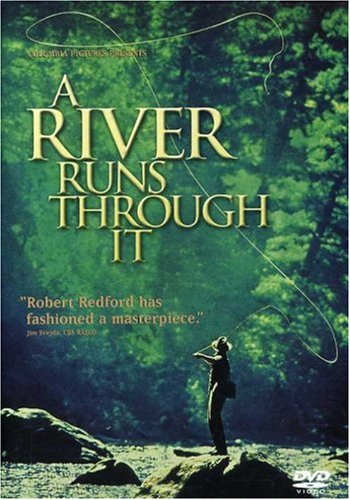Like some of the best film adaptations, A River Runs Through It was based on a short story. I've always believed that movies are too short and small a medium to accurately capture a complete novel...but short stories are another matter entirely. This one was originally published in May 1976, and it's sort of based on a true story.
The Book
The story revolves around the Maclean family, who live in the wide-open spaces of Montana. Fly fishing is what bonds them together. The story is mostly told through Norman's eyes. He's the oldest son, and he goes on one last fishing trip with younger brother Paul. This occurs in the summer of 1937; both men are in their early 30s.
Fishing is a huge part of the story, which is really more of a novella. If you like very long and detailed descriptions of nature and the weather, you will certainly enjoy the print version of this particular tale. In-between descriptions of lures and the like, you'll see the profound relationship between the Maclean brothers. Neither one can really understand each other, but their affection isn't any less because of it.
The story in the book delves much more deeply into the characters than the film, and gives you a much closer look at Norman's struggle to help Paul. The story is taken from a semi-autobiographical novel, a collection of three stories, written by (who else?) Norman Maclean.
The Film
A River Runs Through It is perhaps best-known as being a Brad Pitt movie, but it's a pretty enjoyable period piece in spite of that. Pitt plays Paul, younger brother to narrator Norman (Craig Sheffer). Directed by Robert Redford, the flick was so popular it actually sparked an interest in fly fishing all over the United States.
The two brothers are the sons of a Presbyterian minister. Norman has been away at college for 6 years when the film begins, and Paul has been working as a journalist back home. They are a study of opposites. Norman is straight-laced, and interested in courting the eligible young Miss Jessie Burns. Paul is wild, and chases the ladies as it strikes his fancy. He drinks, he gambles, he does just what he likes...much to Norman's despair.
It's your classic coming-of-age tale...but it's Norman who ends up coming of age, not Paul. If you haven't seen it, what have you been doing? You must seek it out at once. But if you read the story and watch the film, you will find some differences in the two narratives.
What Got Adapted?
You'll get to meet Jessie much more quickly on the page. She appears once the film is already well-established, and she doesn't marry Norman soon enough. Jessie is Mrs. Maclean early in the story, and Norman's ordeal with her brother plays out after they are married.
Paul catches the fish in the movie, but it was really Norman who wrangled the beast on the page. It doesn't happen at the end of the story, either, but more toward the beginning. Certain plot points are also fabricated out of whole cloth for the movie. In the book, Norman doesn't attend Dartmouth or get offered a job in Chicago.
Some of the passages from the story, however, appear in the film verbatim. Some of Brad Pitt's most memorable lines are ripped right from the page, as are Tom Skerritt's as the minister/father.












0 comments:
Post a Comment